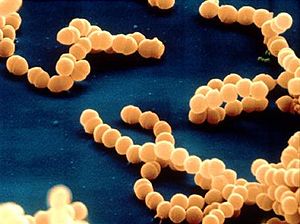Diagnosis and Prevention of Neisseria meningitides Induced Meningitis
By Emily Staudenmaier
Introduction
Meningitis is an inflammation of the membrane surrounding the human brain and spinal cord also known as the meninges. Meningitis can be caused by a bacterial or viral infection. Of the two types of infections, bacterial causation generally results in a more severe infection. The inflammation of the meninges results in headache, neck stiffness, fever, sensitivity to light and sometimes vomiting (Slonczewski). These symptoms can progress quickly when bacteria are behind the infection, resulting in death 10-20% of the time (Tzeng). The bacteria which causes this serious infection is called Neisseria meningitidis.
Neisseria meningitidis is Gram-negative, aerobic, nonmotile, coccal bacteria which is pathogenic only to Homo sapiens. Initial infection occurs in the nasopharynx where the bacteria can bind easily to the mucus membrane using their pilli. When present in the nasopharynx, the bacteria typically do not cause serious health problems to the host. In fact, 5-10% of adults have N. meningitidis present in their nasopharynx and do not develop meningitis. The asymptomatic presence of the bacteria can be beneficial to the human host since it allows antibodies to develop that can be useful in fighting a more serious subsequent infection. The entrance of the bacteria into the bloodstream results in serious consequences for the host. N. meningitidis has the unusual ability to cross the blood-brain barrier and enter the cerebral spinal fluid(Tzeng). The mechanism of this infiltration is unknown. Once the crossing has occurred, the bacteria release inflammatory cytokines which leads to the inflammation of the meninges.
Infection is spread through direct contact with nasal or oral fluids contaminated with the bacteria. Inhalation of large droplet nuclei can also result in the spread of N. meningitidis. Infections are most common and most serious in children, young adults and the elderly. Children who have lost antibodies from their mother and have yet to gain exposure to asymptomatic infections of the bacteria in their nasopharynx, lack any antibiotic immune response to the presence of N. meningitidis. Often the elderly possess weakened immune systems which cause them to be more prone to infection. Young adults, particularly college students, are also apt to contract meningitis simply due to their increased level of exposure to the bacteria due to close contact with others.
Section 1
Include some current research in each topic, with at least one figure showing data.
Section 2
Include some current research in each topic, with at least one figure showing data.
Section 3
Include some current research in each topic, with at least one figure showing data.
Conclusion
Overall paper length should be 3,000 words, with at least 3 figures.
References
Cripps, A., Foxwell, R., and Kyd, J., “Challenges for the development of vaccines against Haemophilus influenzae and Neisseria meningitides”. Current Opinion in Immunology. 2002. Volume 14. p. 553-557
Lansac, N., Picard, F. J., Ménard, C., Boissinot, M., Ouellette, M., Roy, P. H., and Bergeron, M. G. “Novel Genus-Specific PCR-Based Assays for Rapid Identification of Neisseria Species and Neisseria meningitidis”. European Journal of Clinical Microbiology and Infectious Diseases. 2000. Volume 19. p. 443-451.
Sánchez, S., Troncoso, G., Criado, M. T., and Ferreirós, C., “In vitro induction of memory-driven responses against Neisseria meningitidis by priming with Neisseria lactamica”. Vaccine. 2002. Volume 20. p. 2957-2963.
Slonczewski, J., and Foster, J. Microbiology: An Evolving Science. New York: W. W. Norton, 2009.
Taha, M. K., Deghmane, A. E., Antignac, A., Leticia Zarantonelli, M., Larribe, M., and Alonso, J. M. “The duality of virulence and transmissibility in Neisseria meningitidis”. Trends in Microbiology. 2002. Volume 10. p. 376-382.
Tzeng, Y. L. and Stephens, D. “Epidemiology and pathogenesis of Neisseria meningitides”. Microbes and Infection. 2000. Volume 2. p. 687-700.
Edited by student of Joan Slonczewski for BIOL 238 Microbiology, 2009, Kenyon College.

